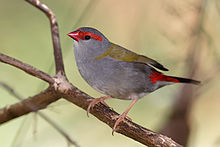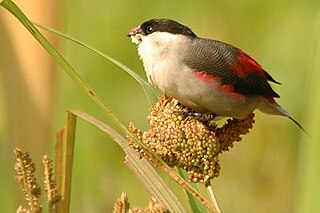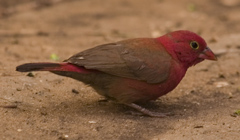| Image | Genus | Living species |
|---|
 | Heteromunia Mathews, 1913 | |
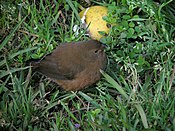 | Oreostruthus De Vis, 1898 | |
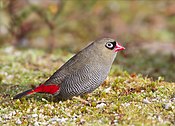 | Stagonopleura Reichenbach, 1850 | |
 | Neochmia Gray, GR, 1849 | |
 | Emblema Gould, 1842 | |
 | Bathilda Reichenbach, 1862 | |
 | Aidemosyne Reichenbach, 1862 | |
 | Stizoptera Oberholser, 1899 | |
 | Taeniopygia Reichenbach, 1862 | |
 | Poephila Gould, 1842 | |
 | Spermestes Swainson, 1837 | |
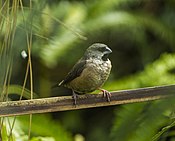 | Lepidopygia Reichenbach, 1862 | |
 | Euodice Reichenbach, 1862 | |
 | Padda Reichenbach, 1850 | |
| Mayrimunia Wolters, 1949 | |
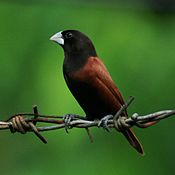 | Lonchura Sykes, 1832 | - Scaly-breasted munia, Lonchura punctulata, also known as nutmeg mannikin or spice finch
- Black-throated munia, Lonchura kelaarti, also known as Jerdon's mannikin
- Black-faced munia, Lonchura molucca
- White-rumped munia, Lonchura striata
- Dusky munia, Lonchura fuscans
- White-bellied munia, Lonchura leucogastra
- New Hanover mannikin, Lonchura nigerrima
- Tricolored munia, Lonchura malacca
- Chestnut munia, Lonchura atricapilla
- White-capped munia, Lonchura ferruginosa
- White-headed munia, Lonchura maja
- Pale-headed munia, Lonchura pallida
- Great-billed mannikin, Lonchura grandis
- Black-breasted mannikin, Lonchura teerinki
- Western alpine mannikin, Lonchura montana
- Eastern alpine mannikin, Lonchura monticola
- Grey-banded mannikin, Lonchura vana
- Grey-crowned mannikin, Lonchura nevermanni
- Hooded mannikin, Lonchura spectabilis
- Mottled mannikin, Lonchura hunsteini
- New Hanover mannikin, Lonchura nigerrima
- Forbes's mannikin, Lonchura forbesi
- Javan munia, Lonchura leucogastroides
- Yellow-rumped mannikin, Lonchura flaviprymna
- Five-colored munia, Lonchura quinticolor
- Chestnut-breasted mannikin, Lonchura castaneothorax
- Black mannikin, Lonchura stygia
- Buff-bellied mannikin, Lonchura melaena
|
 | Chloebia Reichenbach, 1862 | |
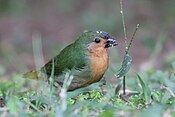 | Erythrura Swainson, 1837 | - Tawny-breasted parrotfinch, Erythrura hyperythra
- Pin-tailed parrotfinch, Erythrura prasina
- Green-faced parrotfinch, Erythrura viridifacies
- Tricolored parrotfinch, Erythrura tricolor
- Blue-faced parrotfinch, Erythrura trichroa
- Red-eared parrotfinch, Erythrura coloria
- Papuan parrotfinch, Erythrura papuana
- Red-throated parrotfinch, Erythrura psittacea
- Fiji parrotfinch, Erythrura pealii
- Red-headed parrotfinch, Erythrura cyaneovirens
- Royal parrotfinch, Erythrura regia
- Pink-billed parrotfinch, Erythrura kleinschmidti
|
 | Nesocharis Alexander, 1903 | |
 | Coccopygia Reichenbach, 1862 | |
 | Mandingoa Hartert, E, 1919 | |
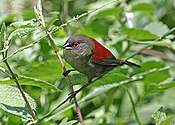 | Cryptospiza Salvadori, 1884 | |
 | Parmoptila Cassin, 1859 | |
 | Nigrita Strickland, 1843 | |
 | Delacourella Wolters, 1949 | |
 | Brunhilda Reichenbach, 1862 | |
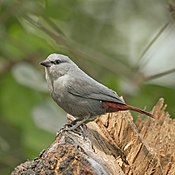 | Glaucestrilda Roberts, 1922 | |
 | Estrilda Swainson, 1827 | - Black-crowned waxbill, Estrilda nonnula
- Black-headed waxbill, Estrilda atricapilla
- Kandt's waxbill, Estrilda kandti
- Orange-cheeked waxbill, Estrilda melpoda
- Anambra waxbill, Estrilda poliopareia
- Fawn-breasted waxbill, Estrilda paludicola
- Common waxbill, Estrilda astrild
- Black-lored waxbill, Estrilda nigriloris
- Black-rumped waxbill, Estrilda troglodytes
- Crimson-rumped waxbill, Estrilda rhodopyga
- Arabian waxbill, Estrilda rufibarba
|
 | Ortygospiza Sundevall, 1850 | |
| Paludipasser Neave, 1909 | |
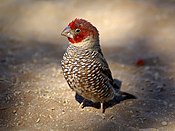 | Amadina Swainson, 1827 | |
 | Amandava Blyth, 1836 | |
 | Granatina Sharpe, 1890 | |
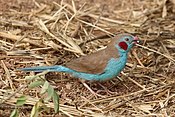 | Uraeginthus Cabanis, 1851 | |
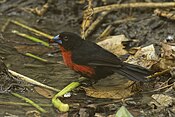 | Spermophaga Swainson, 1837 | |
 | Pyrenestes Swainson, 1837 | |
 | Pytilia Swainson, 1837 | |
 | Euschistospiza Wolters, 1943 | |
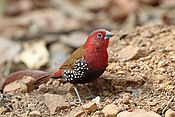 | Hypargos Reichenbach, 1862 | |
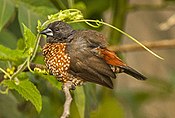 | Clytospiza Shelley, 1896 | |
 | Lagonosticta Cabanis, 1851 | - Bar-breasted firefinch, Lagonosticta rufopicta
- Brown firefinch, Lagonosticta nitidula
- Red-billed firefinch, Lagonosticta senegala
- Black-bellied firefinch, Lagonosticta rara
- African firefinch, Lagonosticta rubricata
- Jameson's firefinch, Lagonosticta rhodopareia
- Mali firefinch, Lagonosticta virata
- Rock firefinch, Lagonosticta sanguinodorsalis
- Black-faced firefinch, Lagonosticta larvata
- Chad firefinch, Lagonosticta umbrinodorsalis
|
|
